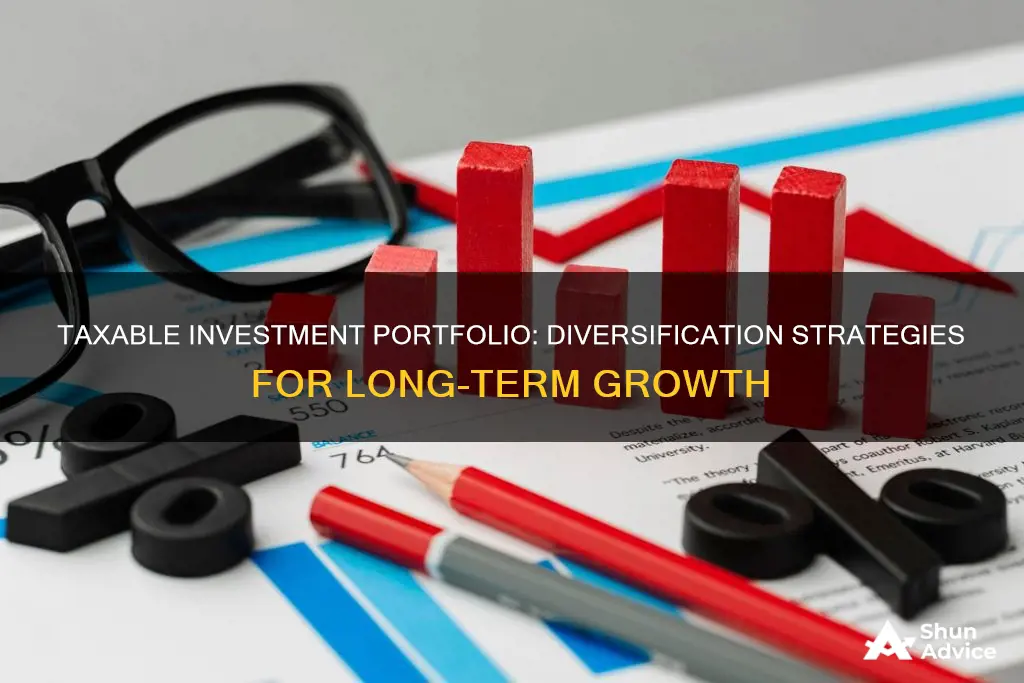
Diversifying a taxable investment portfolio is a crucial strategy to reduce an investor's overall risk and protect their finances from market volatility. By spreading investments across various asset classes, industries, and markets, investors can lower the impact of losses and increase the potential for gains. This approach is commonly known as not putting all your eggs in one basket.
While diversification is a well-known concept, effectively diversifying a taxable investment portfolio requires a thoughtful strategy. It involves investing in a mix of stocks, bonds, real estate, and other alternative investments, considering both domestic and international markets.
Additionally, investors should be mindful of the tax implications of their investment choices. Tax diversification is an important aspect of portfolio management, aiming to reduce long-term tax burdens while maintaining liquidity for short-term expenses.
In the following sections, we will explore specific strategies and tips for diversifying a taxable investment portfolio, including asset allocation, international market exposure, and tax-efficient investment choices.
| Characteristics | Values |
|---|---|
| Number of investments | At least 25 different companies |
| Industries | Tech, energy, healthcare, package delivery, videoconferencing, real estate, etc. |
| Countries | Domestic and international |
| Risk profiles | High, low, growth, value, etc. |
| Investment types | Stocks, bonds, commodities, real estate, etc. |
| Taxes | Fully taxable, tax-advantaged, tax-free |
What You'll Learn

Invest in a variety of asset classes
Diversification is a common investment strategy that involves investing in a range of assets to reduce the risk of market volatility. The three main asset classes are stocks, bonds, and cash or cash equivalents. However, investors can also consider other asset classes such as options, futures, commodities, real estate, and more. Here are some tips to diversify your portfolio by investing in a variety of asset classes:
Invest in Traditional and Alternative Asset Classes
Traditional investments include stocks, bonds, and cash, which operate in the public market. On the other hand, alternative investments primarily operate in the private market and are largely unregulated. They include hedge funds, private equity, real estate, debt investing, commodities, collectibles, and structured products. Alternative investments tend to have a low correlation with traditional assets, making them a valuable addition to your portfolio.
Diversify Across Industries and Markets
When investing in stocks, consider companies of different sizes and from various sectors, such as consumer discretionary, financial services, basic materials, healthcare, and consumer staples. Additionally, look beyond your domestic market and invest in international markets to mitigate the risk of your home country's market performing poorly.
Consider Different Types of Bonds
Bonds offer different levels of creditworthiness, with Treasurys being considered practically risk-free. Integrate bonds from various issuers, such as the federal government, municipalities, and corporations, to add another layer of diversification to your portfolio.
Understand Time Horizons and Liquidity
Traditional investments like stocks, bonds, and cash have no set time horizon and are fully liquid. In contrast, alternative investments like hedge funds, private equity, and real estate have longer time horizons and are relatively illiquid. Building a portfolio with a mix of time horizons and liquidity options provides both flexibility and security.
Evaluate Risks and Potential Threats
While diversification helps spread out risk, it's important to consider the types and levels of risk in your portfolio. Investments with longer time horizons are generally less risky, as the market has more time to correct itself in case of a downturn. However, if the investment is a physical asset, a longer time horizon increases the risk of damage, theft, or loss.
Savings Plans: Invest Now, Reap Long-Term Benefits
You may want to see also

Understand tax diversification
Understanding tax diversification is a crucial aspect of building a robust investment portfolio. Here's a detailed guide:
Understanding Tax Diversification:
Tax diversification is a strategic approach to investing that considers the tax implications of different assets and accounts. The primary goal is to minimize your long-term tax liability while maintaining liquidity for short-term expenses. A well-diversified portfolio in terms of tax will include a mix of fully taxable, tax-advantaged, and tax-free investment accounts. Here's how they work:
Fully Taxable Accounts:
Traditional brokerage accounts, typically consisting of stocks and bonds, fall into this category. These accounts are funded with after-tax money, and you pay taxes on dividends, interest earnings, and capital gains realized from selling investments. The tax amount depends on your tax bracket, the holding period, and the type of dividends received. While these accounts don't offer direct tax benefits, they provide flexibility in terms of withdrawals without penalties.
Tax-Advantaged Accounts:
Retirement accounts like 401(k)s, 403(b)s, and traditional IRAs are examples of tax-advantaged accounts. Contributions to these accounts are made with pre-tax or tax-deductible money and have defined contribution limits. The earnings in these accounts grow tax-deferred until withdrawal during retirement. Withdrawals are then taxed as ordinary income, and early withdrawals may incur additional penalties. These accounts can help lower your taxable income today but could push you into a higher tax bracket in retirement due to Required Minimum Distributions (RMDs).
Tax-Free Accounts:
Roth IRAs, Roth 401(k)s, municipal bonds, 529 savings plans, and health savings accounts (HSAs) fall into this category. These accounts are typically funded with after-tax money, and the earnings grow tax-free. Withdrawals from these accounts are also tax-free if certain conditions are met, such as reaching a certain age or using the funds for qualified expenses. Tax-free accounts provide the benefit of tax-efficient growth and withdrawals during retirement.
Implementing Tax Diversification:
Now that you understand the three main types of accounts, here's how you can implement tax diversification in your investment portfolio:
- Create a mix of tax buckets: Diversify your retirement savings by contributing to both tax-advantaged and tax-free accounts. This approach provides tax benefits now and in the future, allowing you to stay in a lower tax bracket during retirement.
- Consider your life stage: If you're in the early stages of your career and expect your income to increase, prioritizing Roth accounts can be advantageous. Conversely, if you're nearing retirement, traditional tax-advantaged accounts may be more suitable.
- Maintain liquidity: Fully taxable investments, such as interest-bearing accounts and brokerage accounts, offer flexibility for short-term needs. While they may not provide long-term tax benefits, they can be valuable for accessing funds without penalties.
- Optimize asset allocation: Place tax-efficient assets, such as index funds, ETFs, qualified dividend-paying stocks, and municipal bonds, in taxable accounts. On the other hand, place tax-inefficient assets, like mutual funds, actively managed ETFs, and stocks held for the short term, in tax-advantaged accounts.
- Anticipate tax bracket changes: Understand that your taxes may change over time as tax policies evolve and your financial situation changes. Adjust your tax diversification strategy periodically to align with your current tax landscape and financial goals.
Building a Wine Investment Portfolio: A Beginner's Guide
You may want to see also

Diversify within asset classes
Diversification within asset classes is a crucial aspect of building a robust investment portfolio. Here are some detailed strategies to achieve effective diversification within asset classes:
Diversification Within Stocks:
Firstly, it is important to understand that the economic cycle impacts different businesses and their respective stocks differently. Therefore, a key strategy is to invest in companies operating across various industries, reducing market risk. The stock market can be divided into sectors, with some sectors being more sensitive to economic cycles than others.
- Cyclical Sectors: These sectors include consumer discretionary (clothing, electronics, cars, etc.), financial services, basic materials, and real estate. The demand for products and services in these sectors tends to fluctuate with the economic cycle. When the economy is strong, demand for these sectors increases, and vice versa.
- Defensive Sectors: In contrast, defensive sectors include consumer staples (groceries, tobacco, etc.), utilities, and healthcare. These sectors provide essential goods and services that consumers need regardless of the economic climate. As a result, their performance is less impacted by economic cycles.
By investing in a mix of cyclical and defensive sectors, you can reduce the overall risk of your portfolio.
Another factor to consider is the size or market capitalization of companies.
- Large-Cap Stocks: Larger companies tend to be more stable and are better equipped to weather economic downturns. However, they may offer less growth potential compared to smaller companies.
- Small-Cap Stocks: Smaller companies, on the other hand, often have higher growth potential but can be more vulnerable during economic downturns.
Including a mix of large-cap and small-cap stocks in your portfolio can provide a balance between stability and growth potential.
Additionally, you can diversify within stocks by considering the style of the stocks:
- Growth Stocks: These are stocks that are typically more expensive but are expected to have high future growth potential.
- Value Stocks: Value stocks, on the other hand, are considered underpriced or undervalued and may offer greater potential for capital appreciation.
Diversification Within Bonds:
Bonds are another important asset class, offering stable income with modest returns. Diversification within bonds can be achieved by considering factors such as creditworthiness, term length, and bond issuers.
- Creditworthiness: Bonds vary in terms of their creditworthiness or safety. For example, U.S. Treasury bonds are considered low-risk since the federal government backs them. In contrast, corporate bonds may carry more risk but potentially offer higher returns.
- Term Length: Longer-term bonds generally offer higher returns as they are subject to more interest rate risk.
- Bond Issuers: Diversifying across different bond issuers is another strategy. Bond issuers can include the U.S. government, municipalities, corporations, and more. Each type of issuer carries different levels of risk and potential returns.
Geographic Diversification:
Diversifying your portfolio across different geographic markets is another important strategy. Investing in both domestic and international markets can help reduce risk and increase potential returns.
- Domestic Markets: Investing in your home country's stock market allows you to have a better understanding of the market and the companies you invest in.
- International Markets: However, diversifying into international markets can provide a hedge against risks specific to your home country. Developed markets, such as European nations, Australia, and Japan, tend to be more stable, while emerging markets like Brazil, Russia, India, and China offer higher growth potential but come with greater risk.
Mutual Funds, Index Funds, and ETFs:
Investing in mutual funds, index funds, or exchange-traded funds (ETFs) is a popular way to achieve diversification within asset classes. These funds typically hold a diverse range of underlying assets, spreading out your risk. However, it is important to ensure that the funds you choose are indeed diversified and not concentrated in a specific sector or asset class.
In conclusion, effective diversification within asset classes involves a combination of strategies, including investing across different industries, company sizes, stock styles, bond types, and geographic markets. By implementing these strategies, you can reduce risk and increase the potential for long-term returns.
Diversifying Savings and Investments: A Smart Money Move
You may want to see also

Consider alternative investments
Alternative investments are a great way to diversify your portfolio and can be a beneficial addition due to their high level of complementarity with traditional investments. They are any investment besides stocks, bonds, and cash. Alternatives are relatively illiquid and unregulated by the United States Securities and Exchange Commission (SEC).
- Hedge funds pool the capital of many investors and invest it across various securities with the intention of managing risk and aiming to outperform the market's rate of return. They use leverage to increase returns and hedging strategies to reduce risk.
- Private equity involves investing in private companies, encompassing venture capital, growth equity, and buyouts. Private equity firms pool money from investors, improve the company's profitability or value, and then try to sell it for a profit.
- Real estate involves investing in residential, commercial, or retail properties, either individually or through a real estate venture fund or investment trust.
- Debt investing involves investing in the debt of a private company, which can be distressed or private.
- Commodities involve investing in natural resources such as oil, agricultural products, or timber.
- Collectibles involve purchasing items such as rare wines, cars, and baseball cards with the intention of selling them when their value appreciates.
- Structured products involve fixed-income markets and derivatives.
When considering alternative investments, it is important to keep in mind the following factors:
- Time Horizon & Liquidity: Alternative investments have longer time horizons and are relatively illiquid compared to traditional investments.
- Markets & Industries: Select alternative investments from various industries and markets to diversify your portfolio.
- Risks & Potential Threats: Alternative investments provide varying levels of risk. Longer time horizons typically mean less risk, but for physical assets, it can mean more time for the asset to be damaged, stolen, or lost.
By incorporating alternative investments into your taxable investment portfolio, you can further diversify your assets, spread out your risk, and potentially enhance your returns. Remember to always consider your own financial situation and consult with a financial advisor before making any investment decisions.
Savings and Investment: Interplay in a Closed Economy
You may want to see also

Allocate assets based on age and lifestyle
When it comes to allocating assets in your investment portfolio, age and lifestyle are key factors to consider. Here are some detailed guidelines on how to allocate your assets based on these factors:
Age as a Factor in Asset Allocation:
- The general rule of thumb for asset allocation by age is the Rule of 100, where you subtract your age from 100 to determine the percentage of your portfolio that should be in stocks. For example, if you're 30 years old, you should allocate 70% of your portfolio to stocks.
- However, with increasing life expectancies, some experts now suggest using the Rule of 110 or even 120, resulting in a more aggressive stock allocation. Using the Rule of 110, a 30-year-old would allocate 80% to stocks, while a 60-year-old would allocate 50%.
- As you get older, it is generally recommended to shift towards more conservative assets like bonds and cash to reduce risk. Once you retire, you may want to consider a more balanced allocation between stocks and bonds to preserve your spending power.
- Your asset allocation should also take into account your risk tolerance and financial goals. If you are younger and can tolerate higher risk, investing a larger portion of your portfolio in stocks may be suitable.
Lifestyle Considerations:
- Your lifestyle and financial circumstances play a significant role in asset allocation. For example, if you are in your 20s or 30s, you may be more comfortable taking on riskier investments as you have a longer time horizon to recover from potential losses.
- On the other hand, if you are in your 40s or 50s, you may have more financial obligations, such as mortgage payments or saving for your children's education. In this case, allocating a significant portion of your portfolio to stocks can help boost potential growth.
- Additionally, consider your innate risk tolerance. If you are comfortable with market volatility and have a higher risk appetite, you may allocate more to stocks, regardless of your age. Conversely, if market fluctuations cause you stress, opting for a more conservative allocation with a higher percentage of bonds may be more suitable.
- It is important to regularly review and rebalance your asset allocation to ensure it aligns with your evolving financial situation and goals.
In summary, when allocating assets based on age and lifestyle, consider the Rule of 100 or Rule of 110 as a starting point, but also factor in your risk tolerance, financial goals, and life stage. Regularly review and adjust your portfolio to ensure it aligns with your changing circumstances.
Savings Investment Strategies: Where to Invest Your Money Wisely
You may want to see also
Frequently asked questions
Diversification is a way to manage risk in your portfolio by investing in a variety of asset classes and in different investments within those asset classes.
Diversification helps to reduce an investor's overall risk profile and smooth out the peaks and valleys of investing. It also allows for a certain amount of high-return investments by offsetting possible risks through more stable alternatives.
A diversified portfolio should have a broad mix of investments, including stocks from several different industries, countries, and risk profiles, as well as other investments such as bonds, commodities, and real estate.
Here are some quick tips: Invest in at least 25 stocks from various industries or an index fund; include fixed-income assets like bonds; add real estate through REITs; use index funds to boost diversification; and don't forget about cash.
Some common mistakes to avoid include: putting all your eggs in one basket, not diversifying within asset classes, and over-diversification, which can lead to overlapping investments and higher fees without adding much benefit.







